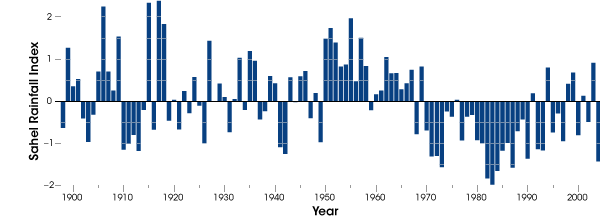| << Chapter < Page | Chapter >> Page > |


Further dramatic changes brought on by recent warming have been observed by scientists concerned with the world’s oceans. Observations of the world’s coral reefs have revealed an alarming rate of coral bleaching (which is not caused by chlorine). As the oceans attempt to uptake the abundance of CO 2 and absorb nearly 80% of the heat added to the earth-atmosphere system from the enhanced greenhouse effect, the waters will inevitably warm. As these waters have warmed over the past 40 years, the delicate ecological balance within some of the world’s coral reefs has been upset leading to coral bleaching. Under warmer waters the rate at which the algae, which is an important part of the coral ecosystem, undergoes photosynthesis is too much for the coral to manage. As a result, the coral rids itself of the algae, which leads to an exposure of the white skeleton of the coral. Another consequence of warming oceans is an increase in sea level. Since 1880, sea level has risen 20 cm (8 inches). The rise in sea level is associated both with an increase in glacial melt water and in the thermal expansion of the seawater. An interesting consequence of this rise in sea level has been the disappearance of the long-disputed New Moore Island between Bangladesh and India. Both countries laid claim to the shallow, uninhabited island due to the speculation that oil reserves may lie beneath it, but in 2010, the sea swallowed it. Scientists at the School of Oceanographic Studies at Jadavpur University, Kolkatta , India suggest global warming played an important part.

Finally, as the planet has adjusted to warmer temperatures the proliferation of drought conditions in some regions has dramatically affected human populations. The Sahel, for example, is a border region between the Sahara Desert in the north of Africa and the tropical rainforests that occupy the central part of the continent. (see Figure The Sahel in Africa ) This region is experiencing desertification as the Sahara steadily expands southward. Since the 1970s, the amount of precipitation in this region has been steadily below normal. The combination of over irrigation and recent climate change has made the region uninhabitable and forced millions to relocate.


In Figure Northern Hemisphere Surface Air the dividing line on the graph is the 1961-1990 average temperature. Explain the relevance of this line to the data presented in this figure.
Explain how deforestation can lead to both a warming effect and cooling effect for global temperatures.
In Figure Atmospheric Transmission , which gas is contributing the most to the absorption of ultra-violet light? If this gas were removed from the atmosphere, how might global temperatures respond?
If the surface of the Greenland Ice Sheet continues to melt, how will this impact the albedo of this region and what impact will this have on the air temperature there?
When sea ice melts, what happens to global sea level?
Walther, G. R., Post, E., Convey, P., Menzel, A., Parmesan, C., Beebee, T. J .C., et al. (2002, March 28). Ecological responses to recent climate change. Nature , 416, 389-395. doi: 10.1038/416389a

Notification Switch
Would you like to follow the 'Sustainability: a comprehensive foundation' conversation and receive update notifications?